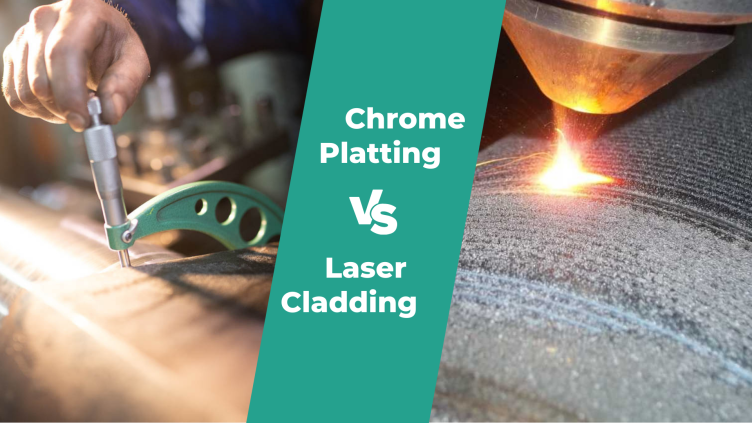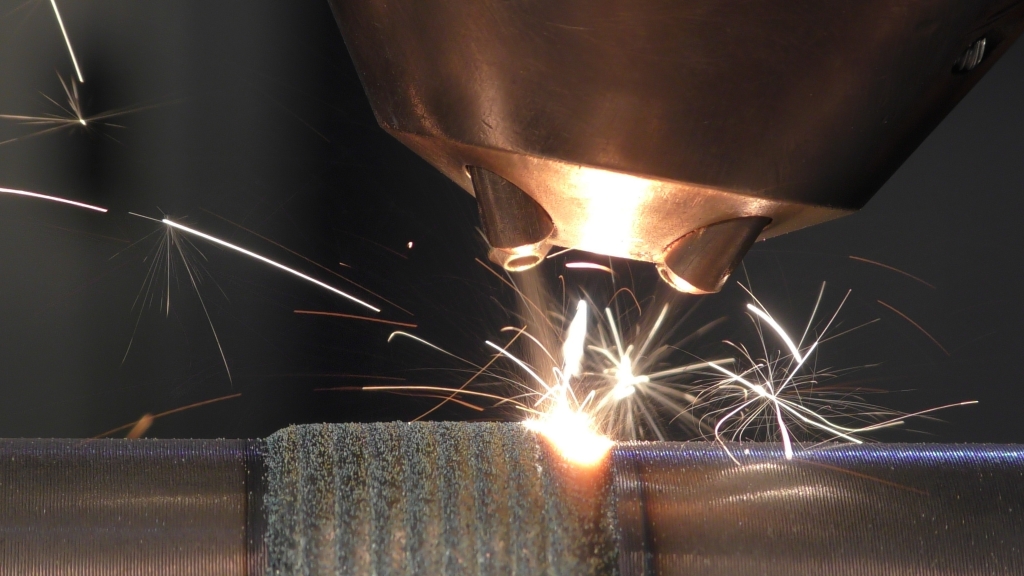

Laser cladding and chrome plating are two notable surface treatment processes that play important roles in industrial applications. Although both attempt to improve material surface qualities, they differ in their operating principles, application regions, and advantages and disadvantages.
To begin, Laser Cladding is a high-tech surface treatment technology that uses a high-energy density laser beam to melt the surface and additional powder material, generating a new alloy layer on the substrate. This approach considerably enhances material wear resistance, corrosion resistance, and high-temperature performance. Laser cladding is well suited for high-performance and high-value industrial applications because to its high accuracy, small heat-affected zone, and diverse material options.
Chrome plating, on the other hand, is a more traditional surface treatment approach that deposits a coating of chrome on the object’s surface via an electrochemical process. This process produces a firm, glossy surface that is often used for ornamental and protective coatings. However, the chrome plating process can generate hazardous waste, endangering both the environment and operator safety.
Individual application demands, cost-effectiveness, and environmental variables all influence the choice between these two technologies in industrial manufacturing and maintenance. Following that, we will go more into the specific application scenarios, strengths and limits of these two technologies, and current industry development trends.
What is Chrome Plating?
Chrome plating, often known as chromium plating, reduces wear and tear and extends the life of metal or technical parts. By applying a layer of chrome on another item, you can increase its corrosion resistance, reduce friction, avoid galling, and, in certain cases, improve its beauty.
Chrome plating is accomplished by the electroplating method, which involves reducing dissolved metal cations in an electrolyte salt bath to allow a smooth metal coating to develop on the target item. The desired object is first cleaned of soil or grime, and the underlying metal is frequently prepared before being put in a chrome plating vat.


The procedure involves different pretreatments depending on the kind of metal being plated to etch the metal for certain metal types to roughen surfaces and prepare the metal for chrome plating.
Types of Chrome Plating
Hard chrome plating and ornamental chrome plating are the two forms of chrome plating, and the type of chrome plating used is heavily depending on the application.
Hard chrome plating, also known as industrial or engineered chrome plating, is a form of chrome plating that applies a thick coat of chromium to engineering parts made of steel. This extends the life of the parts and provides strong resistance to corrosion and wear on pricey metal objects. It is also used to prevent components from seizing and to boost durability.
Hydraulic cylinder rods, molds, piston rings, and other items that require strong chrome finishes are examples. Hard chrome plating covers layers of chrome up to 0.025 inch thick, and while it retains its gleaming luster, it is not employed for aesthetic or ornamental purposes.
Advantages Of Chrome Plating
The advantages of hard chrome plating are obvious to producers in the aircraft sector. Hard chrome plating, a crucial technique for both military and aerospace manufacture and maintenance, offers wear and corrosion-resistant surfaces for essential equipment ranging from hydraulic piston rods and propeller hubs to landing gear, gear shafts, and cannon barrels.
Hard chrome plating has long been the preferred method for hardfacing and dimensional restoration of machine parts due to its traditionally recognized benefits, including:
- There is no heat put into the component.
- Mechanically, the ensuing repair is quite difficult.
- The prices are appealingly cheap.
Disadvantages Of Chrome Plating
However, hard chrome plating also has numerous widely recognized shortcomings, including:
- Chromed surfaces are prone to chipping and delamination because no actual metallurgical link is established.
- The thickness of the deposited hard chrome layer is restricted;
- Hard chrome plating is a very slow electrochemical process.
- Premachining is required before to the plating procedure.
Hard chrome plating has substantial restrictions in both quality and performance as a result of these flaws, particularly in refurbishment applications that demand quick turnaround and heavier accumulation.


Benefit Of Laser Cladding
- Application of thin welded coatings at a low cost 0.5 – 5mm.
- Because of the minimal dilution, proper chemistry may be achieved in a single pass.
- A wide variety of cladding materials are available.
- Because of the extremely tiny heat affected zones, it is possible to clad onto hitherto “unweldable” materials and components.
- Because of the limited heat input, there is less distortion.
- Very precise and repeatable.
- Surface finish is excellent.
- Simple to automate.
Laser Cladding vs Chrome Plating
Because of remarkable cost reductions in lasers in recent years, laser cladding has become a significantly and increasingly cost efficient alternative to hard chrome plating.
The following are some of the advantages of laser cladding:
- The portion receives very little heat, resulting in no deformation.
- Quick turnaround – laser cladding is significantly faster than hard chrome plating.
- There is no more chipping since a real metallurgical link is created with the substrate.
- In most circumstances, premachining is not required.
- When compared to hard chrome plating, laser cladding is more cost effective.
Summary
Laser cladding is also a good alternative to hard chrome plating since it requires less heat, which is especially essential when bigger deposits of material are needed to rebuild a dimension.
Laser cladding is becoming increasingly popular for applications such as CNC spindle repair and resurfacing of motor shafts and other rotating components.
Read More:
